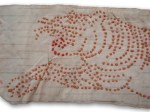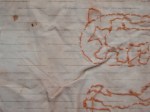 One of my favorite types of WWII militaria are Japanese signed flags (they are called Yosegaki Hinomaru in Japanese) with capture history. There are lots of WWII Japanese signed flags available on the market today. If you look on the internet, there are dozens for sale at any one time. This is because they were one of the most popular souvenirs for WWII vets to bring back from the War. What is hard to find is a signed flag where you have iron clad documentation about the history of the flags capture and/or the Veteran that brought it back.
One of my favorite types of WWII militaria are Japanese signed flags (they are called Yosegaki Hinomaru in Japanese) with capture history. There are lots of WWII Japanese signed flags available on the market today. If you look on the internet, there are dozens for sale at any one time. This is because they were one of the most popular souvenirs for WWII vets to bring back from the War. What is hard to find is a signed flag where you have iron clad documentation about the history of the flags capture and/or the Veteran that brought it back.
This flag came directly from the son of a 1st Raider Battalion Veteran and is part of a larger group that I own to that Veteran. When I got it, his son also included of photo copy of a newspaper article that ran in the Veteran’s hometown paper. The article shows the flag and also talks about it being captured on Guadalcanal.
Although I don’t read Japanese, certain phrases appear often enough on these signed flags that I do know the meaning of them. On this flag, in the right hand vertical column, where the characters are bold and large, from top to bottom the first 5 kanji characters say ” I pray your military fortunes are long lasting”, Ki Buun Chokyu in Japanese. This was a very popular phrase on signed good luck flags and appears on many of them.
Please note that I have also attached a photo of a piece of paper with Japanese writing on it that came from this same Veteran. I do not know what it says, if anyone can give me any kind of a translation, I would be most grateful and would love to update this article with that info. Also, if anyone can give me any help with the translation of the other writing on the flag, I would also be very grateful and would update this article with that info.



















You must be logged in to post a comment.